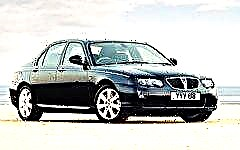Photos and a small review of the tuned Ferrari 458 series.

Probably, we have all seen this more than once: a few small parts made of carbon fiber reinforced plastic are stuck to the body of the car, and the Internet community of tuning lovers is already starting to buzz.
But believe me, when you stand next to one of these creations, you start to feel the idea. You suddenly realize why conflicting feelings like love and disgust are mixed together.
But this is the main reason why the world-famous Kato-san from the Japanese tuning studio Liberty Walk is engaged in the creation of such "works", which are a limited series, single copies. All this is done for fun - to create something like that, and see what kind of reaction it will cause in people, because these are not ordinary cars, these are real supercars with wide bodies.
Unusual start

Kato began preparing this Ferrari for SEMA 2013 in advance, many months before the show. Interestingly, this was not a standard 458 model, but a finished racing version of the Challenge. All over the world, it is bought by gentlemen who want to participate in the Challenge Cup race. It is equipped with an average Ferrari engine (4.5 L V8, 570 hp).
To make it clear what has changed here, here are photos of the production Ferrari 458 Italia:



And now further about our tuned car ...

The thin aluminum body makes the car light: polycarbonate windows, carbon doors, hub-centered rims - it all looks great. Just like a real race car, this Ferrari has a full cockpit roll cage and a sporty interior. All of this is backed up by a dual-clutch transmission, short shifting and no servo brakes.

In fact, you can make a whole list of points that turn this model into a real diamond. Kato's goal was to make the Challenge easy to register to drive on normal roads. He wanted to enjoy this super racing car on city streets as well. Naturally, Kato would not have been Kato if he hadn't planned to tweak this Ferrari a bit. However, these "minor tweaks" have become the complete LB? WORKS package.
Unlike the tuned American supercar, the Kato Challenge has a new carbon fiber front splitter. The center part of the divider, like on the Miuro, is raised, but much stronger and therefore can withstand high speeds. This is very handy, because Kato takes this supercar on the Suzuka-type circuit tracks.

And then those two-piece front fenders. Yes, they had to be cut, but that didn't make them worse! It was a forced move that brought the wheels gracefully into the new-sized arches, giving the Ferrari the look that all cars that came out of the Nagoya workshop stand out for. By the way, probably for aesthetic reasons, Kato-san decided to leave the aerodynamic kits black.
Serious race car application

The original Challenge wheels have been replaced with custom-made 19-inch three-piece HRE S103 wheels. The Challenge suspension along with the adjustable shock absorbers was not touched, they were simply lowered to the highest possible height and Roberuta air bags were added. Thanks to these cushions, when driving in urban conditions, the car can be raised by 5 cm. This is a really useful option that makes driving easier. In reality, equipping the Challenge with the standard Ferrari 458 steering bipod made this supercar equal in handling to its road version.

On closer inspection, you can see the carbon fiber side skirts, which are also a kind of accent. And at the back, it has large body kits that extend all the way to the bumper and wrap around the 458's already not too narrow tailgate.

If the front wheels are 19 × 9 inches, then the rear is much wider 19 × 12-inch HRE rims with a very noticeable offset ET 25. In the raised state on the Roberuta cushions, wheel alignment is almost perfect. The fenders are also perfect. And when the body goes down, all that remains is to admire how all this is perfectly combined with each other.

Aerodynamic body kits LB? WORKS, like everything developed by Miura, give a special style to the exterior of the car. The Ducktail carbon spoiler is like icing on a cake. Yes, this is perhaps the greatest blasphemy to the beautiful and seamlessly flowing body lines of the 458 model, but this spoiler only emphasizes the beauty of the design.

Another good touch is the Challenge's lack of a rear diffuser. Without it, you can see all these oily details, usually hidden from prying eyes: the end of the dual-clutch transmission, the cross member, and if you kneel down, you can see the suspension arms and exhaust pipes.
Kato-san's principles

Kato-san always does his best and does not compromise on the easy path. He is least concerned with the opinions of others. Always trying to preserve the uniqueness of each car, he can get behind the wheel of a sports car and easily drive through the streets, attracting everyone's attention and showing the public what his company is doing. The best advertising cannot be done by any traditional means.

From whatever angle you look, this Ferrari 458 exudes a spirit of perfection everywhere, even in the sound with which it opens and closes doors. To those who do not pay attention to such trifles, the doors may seem flimsy and of poor quality. All design solutions in this Challenge are subordinated to the main goal - to reduce weight.

For the same reason, there are no excesses in the interior. The aluminum chassis is unobstructed, as there are no floor mats or soundproofing in the cabin. But on the other hand, there is a serious safety cage that you need to climb over to get into a carbon seat with all kinds of support. From it you can reach the suede-trimmed steering wheel, where all the controls are located on small switch panels around its spokes.

You can increase or decrease the speed using the paddle shifters. The dual-clutch transmission is more difficult to handle as it looks more like a mechanical one. Downshifting works best. It seems as if explosions mixed with lightning begin to thunder around, and a series of pops and crackles are heard from the exhaust system.

And another interesting question arose. Why would Kato have to install a sound system and speakers in the cabin? But because he can do it. And that's all you need to know.

As for the technical characteristics, there is almost nothing to say about the engine, for example. It has the same 570bhp as the regular version of the car, and the sound it makes is absolutely unmatched.
In order to lighten the weight (the original has a total weight of 1480 kg), a carbon fiber manifold was installed instead of an aluminum intake manifold. Likewise, instead of a triple tailpipe, there is a double tailpipe, and there is no muffler.
- Maximum speed - 325 km / h;
- Acceleration from 0 to 100 km / h - 3.4 seconds;
- Average fuel consumption - 13.7 liters per 100 km;
- Length - 4527 mm;
- Width - 1937 mm;
- Height - 1213 mm;
- Tank volume - 86 l;
- Designer - Pininfarina;
- This Ferrari model has been produced since 2009 (about 1200 cars were sold in 2010).
How many of you were upset to see this Ferrari 458? Kato-san should probably be happy, because that's why he works with machines like this. These cars exist to provide a topic of conversation. After showing off the original model in its original form last year, it's a shock when you see this tuned version.And how can you not love her? After all, cars like her push the boundaries of the possible and advance the art of tuning to the fore.
Other photos of the tuned Ferrari 458:









Ferrari











